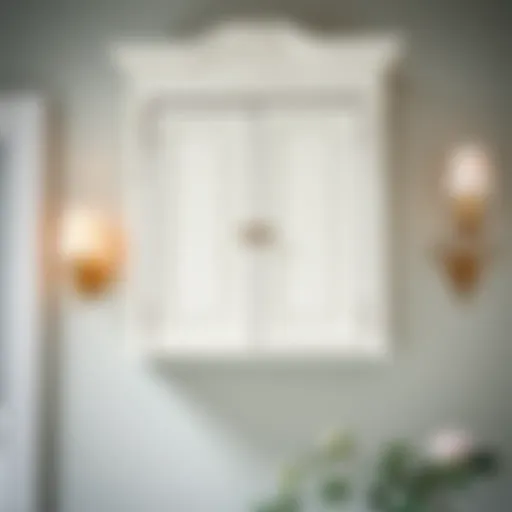Understanding the Impact of 6-Inch Base Cabinets


Intro
In the realm of furniture design, every inch counts. The 6-inch base cabinet may seem like a modest component in the grand scheme of interior aesthetics and functionality, yet its significance cannot be overstated. These cabinets serve as a bridge between elegance and utility, enhancing spaces that often fall into the uncanny valley of clutter. Whether you’re a seasoned interior designer, a budding architect, or a savvy retailer, understanding the dimensions and functions of these cabinets will certainly equip you with the knowledge to make informed design decisions.
From kitchens to bathrooms, and even small commercial spaces, the integration of a 6-inch base cabinet can transform how one utilizes limited square footage. As we dive into this guide, you will discover not only the design trends that shape contemporary cabinet aesthetics but also explore the functional solutions that optimize space and cater to ergonomic needs.
With contemporary spaces increasingly prioritizing both style and practicality, let’s first examine the trends that are turning heads in the world of base cabinets.
Understanding Base Cabinets
Base cabinets are fundamental elements of kitchen and bathroom design, serving as the backbone of functional spaces. Their significance extends beyond mere storage; they influence the overall aesthetics and functionality of an area. For instance, a well-designed base cabinet maximizes the potential of its environment, ensuring both style and practical use.
Definition of Base Cabinets
Base cabinets, as the name implies, are the cabinets that sit on the floor, providing a base for countertops and acting as the primary storage units in kitchens, bathrooms, and utility spaces. Typically, they range in height from 34.5 inches to 36 inches, accommodating standard countertop height for easy accessibility. These cabinets come in various widths and depths, with the 6-inch variety emerging as a notable option for those needing specialized storage in tight spaces. A 6-inch base cabinet can hold items such as spices, cleaning supplies, or dishware that require easy access.
Base cabinets are primarily constructed from materials like plywood, particleboard, or solid wood, depending on the desired aesthetics and budget constraints. The choice of material not only affects durability but also visual appeal.
Historical Context
Historically, cabinets have undergone a transformation from simple storage solutions to intricate design elements that reflect personal style and sophistication. Originating in ancient Egypt where wooden structures were first used for storing valuable goods, the concept of base cabinets evolved through various periods such as the Renaissance, where ornate designs became prominent in wealthy households.
By the 20th century, the role of base cabinets transitioned significantly, aligning with the modern need for convenience and efficiency. The introduction of mass production techniques allowed for modular designs, leading to an array of options suited for both small and expansive spaces. The contemporary market now showcases innovations like soft-close hinges and modular shelving, catering to the ever-growing demands for functional and stylish home interiors.
"The beauty of a home reflects its functionality, and base cabinets play a critical role in marrying both. They are not merely fixtures; they are essential components that enhance the living experience."
Understanding base cabinets is thus about more than just recognizing their physical presence. It is about grasping how they fit into the broader context of home design, standing at the intersection where form meets function.
The Importance of a 6-Inch Base Cabinet
When it comes to efficient space management and functional design, the 6-inch base cabinet shines as an essential element in both residential and commercial environments. It serves multiple purposes that make it not just a piece of furniture, but a solution to various storage dilemmas. As trends lean toward open-concept spaces and minimalism, these compact cabinets are becoming increasingly relevant.
One of the primary benefits of 6-inch base cabinets is space optimization. In many homes, especially those with smaller kitchens or bathrooms, every square inch is precious. A 6-inch base cabinet can fit seamlessly into tight spots or alongside other cabinetry, effectively utilizing areas that might otherwise go untouched. Think of slipping one in beside a refrigerator or as a standalone unit against a wall; its narrow profile provides storage without overwhelming the room.
Another significant factor is the design versatility these cabinets offer. They can be custom-designed to match existing decor or installed as ready-made solutions that enhance aesthetic appeal. From sleek, modern finishes to classic wood designs, a 6-inch base cabinet can complement any style. This adaptability enables homeowners and designers to maintain both functionality and visual harmony in their spaces.
"In a world where space comes at a premium, the right furniture choices can open new doors to creativity and functionality."
Additionally, these cabinets are not limited to kitchens; they have also found a place in bathrooms and utility spaces. Their multi-faceted functionality allows for a diverse array of uses; whether it’s for storing toiletries in a bathroom or organizing tools and supplies in a utility room, their contribution is significant. This adaptability ensures that even the smallest areas can be transformed into functional storage zones, valuing efficiency as much as aesthetics.
In summary, the 6-inch base cabinet is a crucial player in both design and functionality. Its importance goes beyond simple storage; it embodies the principles of smart design in today's compact living spaces. From optimizing square footage to adding a stylish touch, these cabinets stand as testaments to thoughtful design, making them indispensable in modern interiors.
Design Features of a 6-Inch Base Cabinet
When thinking about a 6-inch base cabinet, one might overlook its design features in favor of more prominent elements. However, the design of these cabinets is where the magic happens. It's not just about aesthetics; it involves creating a functional piece that fits seamlessly into any environment. High-quality materials, thoughtful structural components, and exquisite finishing touches come together to make these cabinets essential in maximizing space and utility.
Material Selection
Selecting the right materials for a 6-inch base cabinet is like choosing the right ingredients for a gourmet dish. Each material offers distinct advantages that cater to specific needs. Common materials include plywood, MDF, and solid wood.
- Plywood: Known for its durability and resistance to warping, plywood can withstand the test of time, especially in high-moisture areas like kitchens and bathrooms.
- MDF (Medium Density Fiberboard): Often favored for its smooth finish, MDF is perfect for cabinets that require paint or laminate, providing an ideal surface without the grain variation found in wood.
- Solid Wood: A classic choice, solid wood adds a touch of elegance, even if it comes with a steeper price tag. It is strong, durable, and can be refinished to maintain its appearance over time.
Making a careful choice here not only impacts the aesthetic appeal of the cabinet but also its longevity and performance in daily use.
Structural Components
A well-thought-out structure is paramount for a 6-inch base cabinet. This size may be narrow, yet it must be robust enough to handle weight effectively. Key structural components include the cabinet's frame, shelves, and drawer mechanisms.


- Cabinet Frame: The framework ought to be solidly constructed to bear the weight of items stored inside. A strong frame also ensures that the cabinet doesn't sag over time.
- Shelves: Adjustable shelves provide flexibility for storage, permitting a varied range of items. They should be made from materials that endure wear and can bear weight, particularly if they will hold heavy kitchen appliances or books.
- Drawer Mechanisms: Smooth-operating slides with soft-close features enhance usability and ensure that drawers don’t slam shut, which can be a common nuisance in daily use.
The right structural elements can turn an average cabinet into one that’s both functional and a pleasure to use.
Finishing Touches
The finishing touches on a 6-inch base cabinet can make a world of difference. This is the stage where functionality meets flair. From paint colors and hardware selections to edge banding, these details can either elevate or diminish a cabinet’s overall appearance.
- Paint and Finish: The correct paint can protect the material while providing an aesthetic that matches overall interior design goals. Matte and satin finishes might work well in modern settings, whereas gloss finishes can give off a luxe vibe.
- Hardware: Knobs, handles, and pulls should not only align with the cabinet's design but also be comfortable to use. The material can vary from metal to ceramic, and each type provides a different feel and look.
- Edge Banding: This is the material that covers the exposed particle board or MDF edges. It prevents moisture absorption and adds a finished appearance to the cabinet, contributing to the interior's overall polished look.
These subtle yet impactful finishing touches can certainly define the character of a cabinet.
In summary, when focusing on the design features of a 6-inch base cabinet, it's essential to consider material selection, structural components, and finishing touches. These elements are vital in creating a piece that is not only functional but also enhances the overall aesthetic of the space it occupies.
Functional Applications
Understanding the functional applications of a 6-inch base cabinet is essential in recognizing its versatility in various spaces. This small but mighty piece of furniture can serve numerous purposes across kitchens, bathrooms, and utility areas. As space becomes increasingly tight in modern homes, the utility and strategic placement of a 6-inch cabinet can significantly impact both aesthetics and functionality.
Kitchen Uses
In the kitchen, a 6-inch base cabinet can be a game changer. It fits seamlessly into tight spots, providing unexpected storage without overwhelming the layout. These cabinets are ideal for storing utensils, spices, or even small appliances like toasters or coffee makers. Imagine a scenario where you’ve got a narrow strip of space between your stove and the wall—you can slide in a 6-inch cabinet that not only adds to the storage capacity but can also serve to create a visual focal point.
The clever design of these cabinets enables flexibility in layout, allowing for a built-in nook or even a cozy breakfast bar with the right countertop. Plus, incorporating pull-out shelves or drawers can help maximize accessibility, ensuring that even the farthest corners of the cabinet are not an afterthought. Well-designed cabinetry in kitchens provides additional support surface area that can greatly enhance cooking workflows.
Bathroom Applications
When we pivot towards bathrooms, the compact nature of a 6-inch base cabinet continues to shine. In many bathrooms, particularly smaller ones or powder rooms, adding substantial storage without encroaching on movement is a fine balancing act. A base cabinet here can be used for housing toiletries, cleaning supplies, or linens, and the extra height often allows for attractive installations of sinks, creating a more spacious, open feel.
Using a 6-inch cabinet can also contribute to aesthetic continuity with the rest of the bathroom fixtures. Imagine a chic vanity setup that integrates seamlessly with the rest of the cabinetry in the space—your 6-inch unit can certainly play a vital role in this. Additionally, wall-mounted mirrors can be cleverly paired with low-profile cabinetry to maintain sight lines and enhance functionality.
Utility Spaces
Utility spaces, often relegated to the background of home design, benefit immensely from the inclusion of 6-inch base cabinets. Whether it's a laundry room, garage, or mudroom, these cabinets can be utilized for storing cleaning supplies, gardening tools, or seasonal items in a neat and organized manner. Their compact nature allows for greater efficiency in layout; you can line the walls without sacrificing movement space.
Fitting one of these cabinets in a utility area also encourages tidiness. When there is designated storage, items are less likely to linger around, creating clutter. It transforms the overall functionality of a utility room from chaotic to manageable, making tasks less daunting. In summary, the thoughtful integration of a 6-inch base cabinet can greatly amplify efficiency and organization in any utility space.
"Ingenious storage solutions often transform not just a room, but the daily experiences of those using it."
Choosing the Right 6-Inch Base Cabinet
Selecting the appropriate 6-inch base cabinet is crucial for optimizing spaces in homes and businesses. Choosing wisely goes beyond mere aesthetics; it encompasses functionality, usability, and longevity. In this section, we’ll discuss the integral elements of choosing this specific cabinet dimension, emphasizing its benefits and essential considerations.
Assessing Space Needs
When contemplating a 6-inch base cabinet, the first order of business is to evaluate available space. This dimension might seem trivial, yet it can significantly impact functionality. Think about where this cabinet will reside. Narrow hallways, cramped kitchens, or stylish bathrooms with limited areas are prime candidates for these compact units.
- Measure: Start by measuring not just the area but also the height and depth available to ensure it fits snugly.
- Plan: Visualize the traffic flow in the space. A cabinet that hinders access or makes the area feel cramped will not serve its purpose well.
- Combine Functionality: Consider integrating additional features such as pull-out shelves or drawers within the narrow confines. This will enhance usability without demanding more space.
Taking these steps helps avoid the common mistake of purchasing without a clear understanding of spatial dynamics.
Style Considerations
A 6-inch base cabinet must complement the overall design ethos of the room in which it is placed. While it serves a functional role, its design can be aesthetic or even a focal point.
- Material Choices: From wood to laminate or metals, the material you select impacts the look and durability. For instance, reclaimed wood gives a rustic charm, whereas sleek metal might resonate with modern themes.
- Color Coordination: Selecting colors that mesh well with existing decor is key. A cabinet in a bold hue can stand out for dramatic effect or be painted to match surroundings for a subtler approach.
- Hardware Selection: Knobs and handles—often overlooked—can greatly influence the cabinet’s personality. Consider options that harmonize with both the structure and the general theme of your space.
These considerations allow you to tailor the cabinet so it isn’t just a piece of furniture but an integral part of the room's design identity.
Budgeting


Budgeting for a 6-inch base cabinet involves understanding both the costs associated with buying and maintaining it. Here are some pointers:
- Initial Costs: Analyze not just the price tag of the cabinet but also installation fees that can swing the budget one way or another. Choose suppliers who offer transparent quotes and deliveries.
- Quality Matters: It’s tempting to go for cheaper options, but investing in quality can pay dividends over time. A well-made cabinet will endure wear and tear, making it a worthy investment.
- Future Considerations: Factor in long-term maintenance and durability, as well as potential upgrade needs. Saving a few bucks now can lead to extra costs down the road.
Incorporating these tips will help you navigate the financial aspects of your decision while guaranteeing satisfaction in both the short and long term.
Final Insight: The 6-inch base cabinet is more than a mere storage solution. Choosing the right one requires thoughtful consideration of one’s needs, aesthetic preferences, and budget constraints. Taking time for these evaluations can lead to a harmonious blend of function and flair in any space.
Installation Guidelines
When it comes to integrating a 6-inch base cabinet into your space, understanding the installation process is paramount. Installation Guidelines serve as the backbone for successful usage, ensuring that the cabinet not only fits well but also enhances the overall functionality and aesthetic of the area. Properly executed installation can reduce the risk of damage over time and contribute to lasting satisfaction with the furniture choice. Here, we will outline the preparation steps, mounting techniques, and final adjustments necessary to achieve a seamless installation.
Preparation Steps
Before you even consider mounting your cabinet, preparing the area is crucial. This initial stage facilitates a smooth process and helps avoid common pitfalls.
- Measure Twice, Cut Once: Start by accurately measuring the space where the cabinet will reside. This means considering height, width, and depth—not just the cabinet itself but also surrounding elements. Each inch counts!
- Gather Necessary Tools: Have all required tools on hand, such as a level, drill, screwdriver, and stud finder. A lack of essential tools mid-project can lead to frustration.
- Clear the Area: Ensure the installation zone is clear of any obstacles. Remove existing furniture or fixtures that may hinder the process.
- Check for Level Surfaces: Uneven floors can complicate installation. If the floor isn’t level, consider using shims to create a stable base for your cabinet.
"A well-prepared space will ensure a smoother installation process and leave no room for errors."
Mounting Techniques
Once the area is prepped, it's time for the real work: mounting the cabinet. Several techniques can be employed depending on the cabinet design and the wall structure.
- Direct Wall Mounting: For cabinets that will be attached directly to a wall, locate the studs using a stud finder. This ensures the cabinet has a sturdy anchor. Position the cabinet, then drill pilot holes into the studs before securing it with lag screws.
- Recessed Mounting: If the design allows and it suits your space, a recessed installation provides a sleek profile. This method requires cutting out a section of drywall, ensuring the cabinet sits flush with the wall. Recommendations for this method often include electric tools for precision.
- Floating Cabinets: For a modern twist, consider floating the 6-inch base cabinet. Use mounting brackets to suspend the cabinet from the wall, providing an illusion of space while making cleaning easier underneath. Be sure to consult local building codes to ensure safety.
Final Adjustments
After the cabinet is mounted, conducting final adjustments is essential for both aesthetics and function. A few tweaks can create a cohesive and polished look.
- Level the Cabinet: Use a level again to check for any tilting. If there’s an issue, you can adjust the cabinet position accordingly, often by tweaking the screws.
- Install Doors and Drawers: If your cabinet features doors or drawers, attach them as per the provided instructions. Make sure they open and close smoothly, adjusting the hinges if necessary.
- Seal Gaps: If there are any gaps between the cabinet and the wall, use caulk or trim to cover these spaces. This not only improves the appearance but also protects against moisture damage.
- Inspection: Lastly, take a step back and inspect your work. Ensure everything aligns nicely and you’re satisfied with the setup before considering it complete.
The installation phase is where your careful planning comes together. When executed correctly, your 6-inch base cabinet will not only serve its function but also add to the beauty of your space.
Maintenance and Care
Maintaining a 6-inch base cabinet extends its lifespan and ensures it remains functional and visually pleasing throughout its use. Unlike larger cabinets, a 6-inch model might seem less demanding; however, neglecting proper care can lead to issues that complicate both functionality and aesthetics. When designed with thoughtful consideration, these cabinets can serve as effective storage solutions while enhancing the overall look of a space. Here, we delve deeper into the specific elements and benefits of regular maintenance and targeted care for these essential home fixtures.
Regular Cleaning
Regular cleaning is non-negotiable for any piece of furniture, but it’s particularly vital for base cabinets due to their proximity to various kitchen or bathroom messes. A simple routine can make a world of difference in the longevity of your cabinet.
- Daily Wiping: For surfaces subjected to splashes and spills, a quick daily wipe-down with a damp cloth can prevent build-up. Avoid harsh chemicals which can dull the finish over time—stick to gentle soap solutions.
- Dealing with Stains: Tough stains may require a gentle scrub, but always test a small area first to avoid damaging the finish. Using furniture polish once a month can revive the surfaces, giving them a shiny appearance and protection.
- Dusting Inside and Out: Don’t forget the insides. Dust can accumulate quickly, and disregarding it might lead to both unsightliness and potential pest problems. Remove everything, give the shelves a thorough dusting, and only return items when satisfied with cleanliness.
Remember: A clean cabinet is not only inviting but can also improve the air quality of your home!
Preventative Measures
Preventative measures keep your 6-inch base cabinet functional and looking great for the long haul. Here are several effective strategies:
- Placement Considerations: Avoid placing your cabinets near heat sources or areas with high humidity. This can warp the materials over time, leading to irreversible damage.
- Adding Protective Layers: Consider using coasters or mats within the cabinets to safeguard against scratches and dampness. Small adjustments can produce significant benefits, keeping your cabinets pristine.
- Regular Inspections: Every few months, check for any loose screws or fittings. Tightening them up can prevent bigger headaches later, like shifting shelves or unstable drawers.
- Avoid Overloading: While it's tempting to cram them full, overloading cabinets can lead to structural failure. Be mindful of weight limits and distribute items evenly.
"A stitch in time saves nine." Taking a moment to address small issues now can prevent them from snowballing into larger problems.
Epilogue
Case Studies


Case studies play a crucial role in understanding the practical applications and effectiveness of 6-inch base cabinets within various settings. They provide real-world examples that illuminate design choices, functionality, and space utilization. By analyzing successful implementations, we gain insights that can guide future projects for interior designers, architects, and retailers.
Successful Kitchen Designs
When it comes to kitchens, space is often at a premium. The clever integration of 6-inch base cabinets can transform a cramped area into a functional masterpiece. For instance, consider a modern kitchen designed with an open floor plan. Here, the enlightening use of a 6-inch base cabinet beneath a countertop creates a seamless transition from cooking to dining spaces. This not only provides additional storage for spices and utensils but also maintains the aesthetic flow.
Another noteworthy case is the cozy cottage-style kitchen. Designers opted for a rustic 6-inch base cabinet made from reclaimed wood, perfectly complementing the warm color palette. This cabinet, while small, served a dual purpose—a place for cookbooks and a surface for morning coffee. Such design choices underscore the importance of scale and texture in kitchen design. They remind us that even smaller elements can significantly uplift the overall feel of the space.
"A 6-inch base cabinet can be the unsung hero of a kitchen layout, marrying form with function effortlessly."
The adaptability of these cabinets extends beyond mere storage. Their ability to fit into unexpected nooks—like beside a fridge or underneath a window—provides unique opportunities for maximizing every inch of the kitchen. Additionally, the variety of available finishes allows homeowners to customize their cabinets to match or contrast with existing cabinetry, enhancing visual depth.
Innovative Bathroom Solutions
In bathrooms, 6-inch base cabinets can address similar challenges of limited space. For instance, a sleekly designed 6-inch cabinet can fit snugly between the toilet and the wall, serving as a discreet storage option for toiletries. This type of solution makes efficient use of often-overlooked areas, preventing clutter while maintaining an organized look.
Consider a luxury bathroom layout that features a 6-inch base cabinet integrated within a charming vanity design. The creation of a double vanity using cabinets of this size not only provides ample storage but does so without overwhelming the room's visual balance. Homeowners have the chance to store towels and personal items conveniently, keeping surfaces clear for a serene environment.
Furthermore, some designers have experimented with vertical space by stacking these cabinets with open shelving above. This not only leverages height but also presents a stylish display for decorative items or spa essentials, blending functionality with aesthetic appeal.
Overall, these case studies reflect a broader trend in design that prioritizes efficient use of space without sacrificing style. Understanding these successful applications encourages professionals to reimagine how a simple 6-inch base cabinet can enhance both organization and design within kitchens and bathrooms.
Future Trends
As we peer into the horizon of interior design and cabinetry, the realm of 6-inch base cabinets is witnessing some transformative changes. These shifts are essential for anyone involved in the design, construction, or retail of furniture, particularly for professionals who crave innovation and adaptability in their work. Understanding these future trends not only keeps one ahead of the curve but also aligns with evolving consumer preferences and environmental considerations.
Emerging Materials
The materials used in cabinetry are advancing rapidly. While traditional wood has long been a staple, innovative materials are beginning to break the mold. Manufacturers are exploring materials such as high-density fiberboard (HDF), which offers durability and versatility, enabling designs that were previously unachievable.
Moreover, recycled materials like reclaimed wood and sustainable composites are gaining traction. These materials not only contribute to stylish looks but also foster a sense of responsibility towards our environment. Consider features like:
- Durability: Newer materials often boast increased longevity, withstanding wear and tear.
- Aesthetic Diversity: Options now include finishes that can mimic natural wood grains or provide sleek modern looks, catering to varied design styles.
- Cost-Effectiveness: Emerging materials often provide a more affordable solution without compromising quality.
The focus on emerging materials is pressing. Designers should embrace this evolution to cater to a market that values uniqueness and sustainability. Not to mention, these materials can facilitate a broader range of aesthetic expressions in settings, from modern minimalist kitchens to rustic chic bathrooms.
Sustainability Considerations
Sustainability is becoming more than a trend; it’s now a standard that designers and consumers alike prioritize. Incorporating sustainable practices and materials in the design and selection of 6-inch base cabinets doesn’t just appeal to eco-minded clients; it enhances the overall marketability of a space. Here are key points to consider:
- Resource Efficiency: Sustainable cabinetry often utilizes materials sourced from sustainable forests or those repurposed from other projects, minimizing waste and energy usage during production.
- Low-Emission Finishes: Utilizing finishes that are low in volatile organic compounds (VOCs) promotes healthier indoor air quality, which is increasingly becoming a consumer demand.
- Longevity and Functionality: Choosing sustainably doesn’t mean sacrificing functionality. Well-made cabinets from eco-friendly materials often last longer and are easier to repair rather than replace, thus reducing environmental impact.
A focus on sustainability can be a differentiator in a competitive marketplace, underscoring a commitment to not just style but also stewardship of the planet.
Embracing these trends requires a proactive approach, encouraging designers to seek out both materials and methods that align well with sustainable practices. As we forecast into the future, a balance between innovation, functionality, and eco-friendliness will undoubtedly shape the next generation of base cabinets.
Culmination
In this exploration, we have taken a closer look at the dimensions and functions of the 6-inch base cabinet, revealing its unique role in modern design. Understanding its significance isn't just about knowing where to put one; it encompasses the interplay of aesthetics, functionality, and space management.
Summary of Insights
When assessing the value of a 6-inch base cabinet, several key insights emerge:
- Space Efficiency: These cabinets make use of often overlooked areas, enhancing both storage and functionality without overwhelming the available space. A well-placed 6-inch base cabinet can offer storage solutions even in the tightest corners, ensuring that every inch counts.
- Versatile Design: With various styles and finishes available, these cabinets can easily complement different design aesthetics—from rustic to contemporary. Their adaptability allows them to fit seamlessly into diverse rooms, whether in kitchens, bathrooms, or utility spaces.
- Material Considerations: The choice of material is crucial. Durable materials not only provide strength and longevity but also significantly influence the cabinet’s weight and ease of installation. Opting for quality allows for both beauty and practicality.
“In the world of cabinetry, utility and design must dance a delicate waltz, and the 6-inch base cabinet takes the lead.”
Final Thoughts on Implementation
Implementing a 6-inch base cabinet can provide significant benefits, but it requires a thoughtful approach. Here are some considerations:
- Know Your Space: Before installation, carefully assess the area where you plan to place the cabinet. Measure dimensions accurately and consider how the cabinet will interact with surrounding elements.
- Choose Style Wisely: Whether opting for an elegant wood finish or a sleek laminated look, ensure that the style fits the overall design of the space. A mismatched cabinet can clash with the intended aesthetic.
- Plan for Function: Think about what you'll be storing within it. If you need easy access to frequently used kitchen items, organize internal layouts accordingly.
- Stay Within Budget: A 6-inch base cabinet can be found in an array of price ranges. Assess your budget and look for options that align with your financial plans while still meeting your design needs.
Ultimately, a 6-inch base cabinet extends beyond mere storage; it acts as an influential player in achieving a well-organized and visually appealing environment. As designers and architects continue to prioritize multi-functional furniture, the significance of these cabinets becomes ever clearer.















